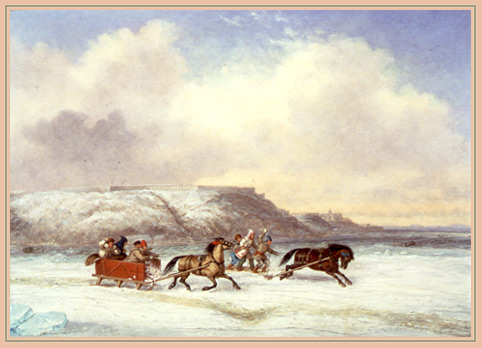Month: December 2004
Fascinating articles I wish I understood
This one is about quantum Darwinism. Worlds in which micro-states collapse into macro-states coherently have superior survival properties, or so it would seem…
How much should governments influence norms?
Colombian politicians have been consulting with Douglass North about how to improve citizen behavior:
Another innovative idea was to use mimes to improve both traffic and
citizens’ behavior. Initially 20 professional mimes shadowed
pedestrians who didn’t follow crossing rules: A pedestrian running
across the road would be tracked by a mime who mocked his every move.
Mimes also poked fun at reckless drivers. The program was so popular
that another 400 people were trained as mimes.
That is just the beginning:
Mockus [the driver behind these ideas and the now-former mayor of Bogota] taught vivid lessons with these tools. One time, he asked
citizens to put their power to use with 350,000 "thumbs-up" and
"thumbs-down" cards that his office distributed to the populace. The
cards were meant to approve or disapprove of other citizens’ behavior;
it was a device that many people actively – and peacefully – used in
the streets.He also asked people to pay 10 percent extra in voluntary taxes. To the
surprise of many, 63,000 people voluntarily paid the extra taxes. A
dramatic indicator of the shift in the attitude of "Bogotanos" during
Mockus’ tenure is that, in 2002, the city collected more than three
times the revenues it had garnered in 1990.Another Mockus inspiration was to ask people to call his office if
they found a kind and honest taxi driver; 150 people called and the
mayor organized a meeting with all those good taxi drivers, who advised
him about how to improve the behavior of mean taxi drivers. The good
taxi drivers were named "Knights of the Zebra," a club supported by the
mayor’s office.
And get this:
To encourage Colombians skeptical of his ability to tackle the chaos and disorder of the city, he [Mockus] publicly donned a superman costume and renamed himself "Supercitizen".
Here is the full story, and thanks to Eric Crampton for the pointer. If you read Spanish, here is an essay by Mockus on his philosophy.
How much were those gifts worth anyway?
1. I enjoyed the giving at $100, the amount I spent. In this case
the net benefits are $150, yet it took only $100 worth of resources (assuming the
gift was produced competitively). Christmas is an excellent deal.
2. I enjoyed the giving at $50, which was the value to my sister. I
like giving gifts, but only insofar as other people like receiving
them. In this case there is no deadweight loss. The benefits sum to $100, precisely the social cost of producing the gift. [Hey, what if my sister enjoys the fact that I enjoy giving to her, I enjoy that she enjoys, and so on…?]
3. I don’t enjoy giving at all, but I need to signal attachment to
avoid the collapse of my social relationships. We could then estimate
the value of the resulting signaling and sorting effects, but the value
of giving is zero.
Now shift gears just a bit. The U.S. government is running significant unfunded
liabilities over the course of the next two generations. Might we respond by offering the next generation greater gifts?
If you
believe #1 as a more general account of giving, the value to a gift donor is in the personally chosen
sacrifice, not the produced net benefit to the recipient. We have already chosen personally
optimal levels of sacrifice, and won’t much increase our gift bequests
(i.e., savings) to help out descendants when their circumstances worsen.
If you believe #2, we more likely care about how much net
value our behavior produces, and not just about the cost of a single
sacrifice. We might then be more inclined to increase savings and
bequests to offset future economic difficulties. If you believe #3, we are selfish and won’t
save and bequeath any more than we have to. All of these scenarios can be given different
assumptions and twists, but that is my first cut approximation at the
correct answers. Ricardian Equivalence involves some very particular assumptions about the structure of altruism.
The bottom line: The best-case scenario for the value of
Christmas is not the best-case scenario for the future of the American
economy. Are you thinking more about what you spent, or more about how
much your gifts were enjoyed? It is the latter scenario that offers cause for a more general economic optimism.
Thanks to Blake for the pointer and query.
Time-inconsistent gift strategies
Not one of us in the family adhered to this agreement.
How to save an insolvent art museum?
James S. Maroney, former vice-president of American painting at Sotheby’s, has submitted to the court a plan to save the Barnes Foundation’s finances and keep the collection in Merion on the outskirts of Philadelphia. Mr. Maroney’s plan entails selling life interest in individual paintings: each buyer would pay 10% or more of a painting’s value and would "own" the rights to display the painting for the rest of the buyer’s life. The Barnes would take the painting back when the buyer died…the revenues would be used for an endowment of some $200 million…
All this could be done without lending out the 100 "most desirable" paintings from the collection. And if the museum has a lower discount rate for these paintings than do individuals, the trade makes economic sense. There is, however, only one known precedent in the past (the Denver Art Museum), and informed opinion predicts the proposal will not be adopted. Furthermore the plan fails if it turns out that people buy pictures simply to own them, rather than to look at them.
The quotation is from the December 2003 The Art Newspaper, p.14
Politically Incorrect Chef
Here from Anthony Bourdain’s Les Halles Cookbook is the glossary entry for foie gras.
Foie Gras: The fattened liver of a goose or duck. Unfortunately, an endangered menu item with the advent of angry, twisted, humorless, anti-cruelty activists who’ve never had any kind of good sex or laughed heartily at a joke in their whole miserable lives and who are currently threatening and terrorizing chefs and their families to get the stuff banned. Likely to disappear from tables outside France in our lifetimes.
The new MOMA
I’ve visited the new and expanded Museum of Modern Art twice in the last week. I am bowled over. In essence New York City has created a new modern art museum by doubling the size of the old. If nothing else, the new museum gives adequate space and attention to prints and drawings. The paintings have more space, there are more of them out, and each room is beautifully hung.
Some winners: Jackson Pollock, William Kentridge, Donald Judd, Sigmar Polke, Chris Ofili, Jasper Johns, and Monet’s Water Lilies.
Some losers: David Salle, Eric Fischl, Julian Schnabel, and John Currin, all nowhere to be found.
Whether you agree with the vision or not, this building has just rewritten the history of modern and contemporary art.
1 in 45
Those are the latest odds of an asteroid hitting the earth in 2029. Here was my previous post. Here is a related article.
Thanks to Bruce for the pointer.
Addendum: Here are links.
Merry Christmas
Merry Christmas
Here is my favorite painting by Leonardo da Vinci, his Annunciation…Merry Christmas and Happy Holidays. Click to enlarge.
300-1
Those are the current odds of a 1,300 foot asteroid hitting the earth in 2029, read more here. Here is our previous commentary on asteroids.
Who is to blame for the deadweight loss of Christmas?
The elderly, for a start:
The most inappropriate gifts, costing 50 per cent more than their value to the recipients, come from elderly relatives. Sensibly, many elect to give cash instead. Unsurprisingly, friends and partners give less wasteful gifts. It’s interesting to note that the most wasteful presents are those that cost roughly between Pounds 25 and Pounds 50 – expensive enough to assuage the guilt of a hurried choice, but cheap enough not to require double-checking with those close to the recipient.
Read more here.
Addendum: This year my mother and sister (their idea) stipulated that we would not exchange Christmas presents. Of course these agreements are easiest to make in exactly those cases where you need them least.
*Everyone* needs video games before surgery
Most of all, the surgeons:
Surgeons who play video games three hours a week have 37 percent fewer errors and accomplish tasks 27 percent faster, he [James Rosser] says, basing his observation on results of tests using the video game Super Monkey Ball.
But the patients too. Perhaps they could play against each other, no?
Read more here.
Larry White recommends Bollywood movies
My own choice for best of 2004: Mazbool and Ab Tak Chhappan. Best of 2003: Bhoot, Waisa Bhi Hota Hai Part II. Bhoot is a ghost story, the others are gritty cop/mafia dramas.
All-time favorites: Sholay, Bombay, Lagaan, Don, The Great Gambler, Mard, Suhaag, Amar Akbar Anthony, Satya, Company, Ganga ki Saugand, Kasam Suhag ki, Nagin, Umrao Jaan, Mera Gaon Mera Desh. I admit soft spots for gangsters, Amitabh Bachchan, dacoit movies, Rekha, and camp.
Here is Larry’s home page. Here are his on-line articles. Here are his links on money and free banking.
Is it easy to start a new private school?
If David wants to start a private school, he must slay four Goliaths [in California]:
The State Environmental Quality Act, which imposes several obstacles to acquiring a piece of land or modifying a structure on that land;
City zoning requirements, which impose restrictions on the location of the private school;
City parking requirements; and
State and local building codes, which deal with the school building itself.
Plus, of course, tuition will not be free. But we frequently underestimate the role of "micro-regulation" in stifling competition and innovation. Read the whole thing, courtesy of the Reason Foundation.

